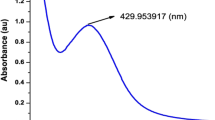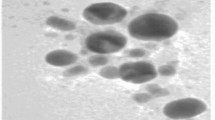Abstract
The use of herbal medicine products is well recognized since the advent of mankind having very little side effects. Biological procedures as eco-friendly and cost-effective routes are important in the synthesis of nanoparticles and nanomaterials. In this work, biological attitude was aimed at production of nanoparticles by Helichrysum graveolens. Several procedures used to describe fabricated nanoparticles are transmission electron microscopy (TEM), ultraviolet-visible (UV–Vis) spectrometry, and Fourier transform infrared spectroscopy (FTIR). Ultraviolet-visible technique indicated sharp peak in area 439 nm and TEM pictures show that the shape of the nanoparticles (NPs) is spherical and the mean diameter of synthesized nanoparticle is 11 nm. The biosynthesized NPs exhibited antimicrobial properties against predominant pathogenic bacteria (Staphylococcus aureus, Staphylococcus epidermis, Pseudomonas aeruginosa, Escherichia coli). The green-synthesized NPs show anticancer activity against colon cancer cell line (C26) which depends on time and concentrations. Also, the synthesized AgNPs act as a green catalyst because of accelerate degradation of stable and organic dye (Methylene Orange). Consequences established this protocol as easy, fast, and alternative conventional physico-chemical approaches.








Similar content being viewed by others
References
Darroudi, M., Yazdi, M. E. T., & Amiri, M. S. (2020). Plant-mediated biosynthesis of nanoparticles. In 21st Century Nanoscience–A Handbook (pp. 1–1). Boca Raton: CRC Press.
Sivasankarapillai, V. S., et al. (2020). On facing the SARS-CoV-2 (COVID-19) with combination of nanomaterials and medicine: Possible strategies and first challenges. Nanomaterials, 10(5), 852.
Javadi, F., et al. (2019). Biosynthesis, characterization of cerium oxide nanoparticles using Ceratonia siliqua and evaluation of antioxidant and cytotoxicity activities. Materials Research Express, 6(6), 065408.
Aseyd Nezhad, S., Es-haghi, A., & Tabrizi, M. H. (2020). Green synthesis of cerium oxide nanoparticle using Origanum majorana L. leaf extract, its characterization and biological activities. Applied Organometallic Chemistry, 34(2), e5314.
Shaheen, M. N., El-hadedy, D. E., & Ali, Z. I. (2019). Medical and microbial applications of controlled shape of silver nanoparticles prepared by ionizing radiation. BioNanoScience, 9(2), 414–422.
Sharifan, H. (2020). Alarming the impacts of the organic and inorganic UV blockers on endangered coral's species in the Persian Gulf; a scientific concern for coral protection. Sustainable Futures, 100017. https://doi.org/10.1016/j.sftr.2020.100017.
Nisar, P., et al. (2019). Antimicrobial activities of biologically synthesized metal nanoparticles: an insight into the mechanism of action. JBIC, Journal of Biological Inorganic Chemistry, 24(7), 929–941.
Sharifan, H., Moore, J., & Ma, X. (2020). Zinc oxide (ZnO) nanoparticles elevated iron and copper contents and mitigated the bioavailability of lead and cadmium in different leafy greens. Ecotoxicology and Environmental Safety, 191, 110177.
Sytu, M. R. C., & Camacho, D. H. (2018). Green synthesis of silver nanoparticles (AgNPs) from Lenzites betulina and the potential synergistic effect of AgNP and capping biomolecules in enhancing antioxidant activity. BioNanoScience, 8(3), 835–844.
Ma, X., et al. (2020). Simultaneous reduction of arsenic (As) and cadmium (Cd) accumulation in rice by zinc oxide nanoparticles. Chemical Engineering Journal, 384, 123802.
Hamidi, A., et al. (2019). Biological synthesis of silver nanoparticles in Tribulus terrestris L. extract and evaluation of their photocatalyst, antibacterial, and cytotoxicity effects. Research on Chemical Intermediates, 45(5), 2915–2925.
Yazdi, M. E. T., et al. (2019). Phyto-synthesis of silver nanoparticles using aerial extract of Salvia leriifolia Benth and evaluation of their antibacterial and photo-catalytic properties. Research on Chemical Intermediates, 1–12. https://doi.org/10.1007/s11164-018-3666-8.
Fathy, M. M. (2019). Biosynthesis of silver nanoparticles using thymoquinone and evaluation of their radio-sensitizing activity. BioNanoScience, 1–7. https://doi.org/10.1007/s12668-019-00702-3.
Yazdi, M. E. T., et al. (2019). Plant-based synthesis of silver nanoparticles in Handelia trichophylla and their biological activities. Bulletin of Materials Science, 42(4), 155.
Jain, A., et al. (2018). Nanomaterials in food and agriculture: an overview on their safety concerns and regulatory issues. Critical Reviews in Food Science and Nutrition, 58(2), 297–317.
Mathur, P. et al. (2018). Pharmaceutical aspects of silver nanoparticles. Artificial cells, nanomedicine, and biotechnology, 46.sup1, 1–12. https://doi.org/10.1080/21691401.2017.1414825.
Shin, K. S., et al. (2009). Facile synthesis and catalytic application of silver-deposited magnetic nanoparticles. Catalysis Letters, 133(1–2), 1–7.
Zhang, S., et al. (2017). Fully printed silver-nanoparticle-based strain gauges with record high sensitivity. Advanced Electronic Materials, 3(7), 1700067.
Jun, B. H., et al. (2010). Multifunctional silver-embedded magnetic nanoparticles as SERS nanoprobes and their applications. small, 6(1), 119–125.
Pandey, R., et al. (2018). Highly conductive copper film on inkjet-printed porous silver seed for flexible electronics. Journal of the Electrochemical Society, 165(5), D236.
Zarei, M., et al. (2020). Comparative study on the biological effects of sodium citrate-based and apigenin-based synthesized silver nanoparticles. Nutrition and Cancer, 1–9. https://doi.org/10.1080/01635581.2020.1801780.
Taghavizadeh Yazdi, M. E., et al. (2019). Eco-friendly and plant-based synthesis of silver nanoparticles using Allium giganteum and investigation of its bactericidal, cytotoxicity, and photocatalytic effects. Materials Technology, 34(8), 490–497.
Wu, X., Li, H., & Xiao, N. (2018). Advancement of near-infrared (nir) laser interceded surface enactment of proline functionalized graphene oxide with silver nanoparticles for proficient antibacterial, antifungal and wound recuperating therapy in nursing care in hospitals. Journal of Photochemistry and Photobiology B: Biology, 187, 89–95.
Velusamy, P., et al. (2015). Greener approach for synthesis of antibacterial silver nanoparticles using aqueous solution of neem gum (Azadirachta indica L.). Industrial Crops and Products, 66, 103–109.
Chitsazi, M. R., et al. (2016). Synthesis of silver nanoparticles using methanol and dichloromethane extracts of Pulicaria gnaphalodes (Vent.) Boiss. aerial parts. Artificial cells, nanomedicine, and biotechnology, 44(1), 328–333.
Francis, S., et al. (2018). Microwave assisted green synthesis of silver nanoparticles using leaf extract of elephantopus scaber and its environmental and biological applications. Artificial cells, nanomedicine, and biotechnology, 46(4), 795–804.
Pillai, A. M., et al. (2020). Green synthesis and characterization of zinc oxide nanoparticles with antibacterial and antifungal activity. Journal of Molecular Structure, 128107. https://doi.org/10.1016/j.molstruc.2020.128107.
Rahdar, A., et al. (2018). Xanthan gum-stabilized nano-ceria: green chemistry based synthesis, characterization, study of biochemical alterations induced by intraperitoneal doses of nanoparticles in rat. Journal of Molecular Structure, 1173, 166–172.
Es-haghi, A., et al. (2019). The expression of antioxidant genes and cytotoxicity of biosynthesized cerium oxide nanoparticles against hepatic carcinoma cell line. Avicenna Journal of Medical Biochemistry, 7(1), 16–20.
Emami, S., et al. (2012). Les espèces de plantes médicinales utilisées par les guérisseurs traditionnels dans la province de Khorasan, nord-est de l'Iran. Journal of Ethnopharmacology, 48, 48–59.
Amiri, M. S., & Joharchi, M. R. (2013). Ethnobotanical investigation of traditional medicinal plants commercialized in the markets of Mashhad, Iran. Avicenna Journal of Phytomedicine, 3(3), 254.
Yazdi, M. E. T., et al. (2018). Role of Ribes khorassanicum in the biosynthesis of AgNPs and their antibacterial properties. IET Nanobiotechnology, 13(2), 189–192.
Sharma, P., et al. (2018). Green synthesis of silver nanoparticle capped with Allium cepa and their catalytic reduction of textile dyes: an ecofriendly approach. Journal of Polymers and the Environment, 26(5), 1795–1803.
Kumar, B., et al. (2017). Green synthesis of silver nanoparticles using Andean blackberry fruit extract. Saudi journal of biological sciences, 24(1), 45–50.
Yazdi, M. E. T., et al. (2018). Biosynthesis, characterization, and antibacterial activity of silver nanoparticles using Rheum turkestanicum shoots extract. Research on Chemical Intermediates, 44(2), 1325–1334.
Rahnama, M., et al. (2017). Efficient targeted mutagenesis in Epichloë festucae using a split marker system. Journal of Microbiological Methods, 134, 62–65.
Rahnama, M., et al. (2018). The global regulatory protein VelA is required for symbiosis between the endophytic fungus Epichloë festucae and Lolium perenne. Molecular Plant-Microbe Interactions, 31(6), 591–604.
Rahnama, M., et al. (2019). The LaeA orthologue in Epichloë festucae is required for symbiotic interaction with Lolium perenne. Fungal Genetics and Biology, 129, 74–85.
Bakavoli, M., et al. (2011). Synthesis of new derivatives of 3-aryl-1, 5-dimethyl-1H-[1, 2, 4] triazolo [4′, 3′: 1, 2] pyrimido [4, 5-e][1, 3, 4] oxadiazines as potential antiproliferative agents. Journal of Heterocyclic Chemistry, 48(1), 183–187.
Shemshian, M., et al. (2014). Saffron in metabolic syndrome: its effects on antibody titers to heat-shock proteins 27, 60, 65 and 70. Journal of Complementary and Integrative Medicine, 11(1), 43–49.
Tayarani-Najarani, Z., et al. (2012). Wogonin and neobaicalein from Scutellaria litwinowii roots are apoptotic for HeLa cells. Revista Brasileira de Farmacognosia, 22(2), 268–276.
Zamiri-Akhlaghi, A., et al. (2011). Study of cytotoxic properties of Rosa damascena extract in human cervix carcinoma cell line. Avicenna Journal of Phytomedicine, 1(2), 74–77.
Aulino, P., et al. (2010). Molecular, cellular and physiological characterization of the cancer cachexia-inducing C26 colon carcinoma in mouse. BMC Cancer, 10(1), 363.
Mashreghi, M., et al. (2020). Anti-Epcam aptamer (Syl3c)-functionalized liposome for targeted delivery of doxorubicin: In vitro and in vivo antitumor studies in mice bearing C26 colon carcinoma. Nanoscale Research Letters, 15, 1–13.
Azizi, S., Nosrati, H., & Danafar, H. (2020). Simple surface functionalization of magnetic nanoparticles with methotrexate-conjugated bovine serum albumin as a biocompatible drug delivery vehicle. Applied Organometallic Chemistry, 34(4), e5479.
Alinezhad, H., et al. (2019). SO3H-functionalized nano-MGO-D-NH2: Synthesis, characterization and application for one-pot synthesis of pyrano [2, 3-d] pyrimidinone and tetrahydrobenzo [b] pyran derivatives in aqueous media. Applied Organometallic Chemistry, 33(3), e4661.
Baghani, M., & Es-haghi, A. (2020). Characterization of silver nanoparticles biosynthesized using Amaranthus cruentus. Bioinspired, Biomimetic and Nanobiomaterials, 9(3), 129–136. https://doi.org/10.1680/jbibn.18.00051.
Rasal, S. A., Tamore, M. S., & Shimpi, N. G. (2019). Ultrasound-mediated synthesis of novel α-aminophosphonates using graphene nanosheets-silver nanoparticles (GNS-AgNPs) as a recyclable heterogeneous catalyst. ChemistrySelect, 4(8), 2293–2300.
Kim, S., & Ryu, D. Y. (2013). Silver nanoparticle-induced oxidative stress, genotoxicity and apoptosis in cultured cells and animal tissues. Journal of Applied Toxicology, 33(2), 78–89.
Naraginti, S., et al. (2015). Zirconium and silver co-doped TiO2 nanoparticles as visible light catalyst for reduction of 4-nitrophenol, degradation of methyl orange and methylene blue. Spectrochimica Acta Part A: Molecular and Biomolecular Spectroscopy, 135, 814–819.
Funding
This work was supported by the Islamic Azad University.
Author information
Authors and Affiliations
Corresponding author
Ethics declarations
Conflict of Interest
None.
Research Involving Humans and Animal Statement
None.
Informed Consent
None.
Additional information
Publisher’s Note
Springer Nature remains neutral with regard to jurisdictional claims in published maps and institutional affiliations.
Rights and permissions
About this article
Cite this article
Taghavizadeh Yazdi, M.E., Amiri, M.S., Akbari, S. et al. Green Synthesis of Silver Nanoparticles Using Helichrysum graveolens for Biomedical Applications and Wastewater Treatment. BioNanoSci. 10, 1121–1127 (2020). https://doi.org/10.1007/s12668-020-00794-2
Accepted:
Published:
Issue Date:
DOI: https://doi.org/10.1007/s12668-020-00794-2




